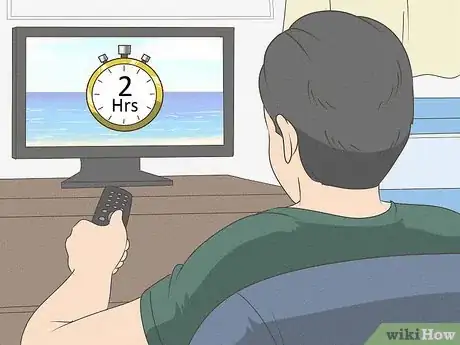This article was co-authored by Michele Dolan. Michele Dolan is a BCRPA certified Personal Trainer in British Columbia. She has been a personal trainer and fitness instructor since 2002.
There are 9 references cited in this article, which can be found at the bottom of the page.
This article has been viewed 52,598 times.
Middle age spread, the tendency to accumulate fat around your abdomen as you get older, doesn’t have to be an inevitability. It’s natural to gain weight as you age beginning as early as your 30’s or 40’s. However, you can avoid the dreaded “love handles” or “beer belly” of middle age spread by following a healthy diet and maintaining an active lifestyle.[1] Keep the weight off to feel better and decrease your risk for long-term illness like heart disease, diabetes, arthritis, and some cancers.[2]
Steps
Building Healthy Habits
-
1Create healthy habits when you’re young. Don’t wait until you’re 50 to start eating right and working out. The easiest way to have good habits when you’re older is to start them when you’re young, then simply adapt them as your body changes. You might feel challenged trying to change your diet or find time in your schedule to exercise – remember that practice makes perfect, so start today!
-
2Acknowledge that your body is changing. With age come changes in your hormones and metabolism. You will start to lose muscle mass and gain a little more fat overall, which means your body doesn’t burn calories like it used to. The first step to preventing unwanted weight gain is recognizing that you may need to improve your habits just to keep your current shape. Start eating a healthier diet, increase your amount of physical activity, or both.[3]
- If you have always lived a healthy lifestyle, keep it up! Do not be discouraged if it becomes harder to maintain your fitness and shape over time.
Advertisement -
3Seek out supportive people. Surround yourself with friends and family who encourage your goal of maintaining a healthy weight.[4] Include others in your shopping and meal planning and cook healthy meals together. Have a “gym buddy” or “walking partner” and hold each other accountable for getting your exercise. You’ll find it easier to maintain good habits when supportive people are involved.
- Help your friends and colleagues avoid middle age spread, too. Set a challenge to all lose weight and keep fit together.
-
4Get enough sleep. People who do not get enough sleep tend to snack more and consume more calories.[5] Being sleep-deprived can also affect your mood and energy, making it harder to stay active. Aim to get 7-9 hours of sleep every night.[6] Tips for getting good sleep include:[7]
- Follow a regular sleep schedule. Go to bed and wake up around the same time each day.
- Don’t nap too much during the day.
- Avoid caffeine after 4pm, or earlier if you’re sensitive to caffeine.
- Use your bedroom only for sleeping to train your brain that “bed” means “sleep.” Don’t watch TV in your bedroom.
- Develop a relaxing bedtime routine. Have a warm bath, read a book, give yourself a hand massage, or have a cup of decaf tea.
Maintaining a Healthy Diet
-
1Decrease your caloric intake. You may need to eat 200 fewer calories in your 50’s than you did in your 30’s and 40’s. However, getting vitamins and nutrients is just as important – and keeping up your calcium and vitamin D is even more important now to prevent osteoporosis.[8] Limit calories without losing nutritional value by choosing the right foods.[9]
- It will help to keep a food journal. Write down what you eat every day. Look at food labels and record the calories you’re getting from your foods. Take into account what is a serving size for what you’re eating – if the label lists an item as 200 calories but you’re eating three times the serving size, that’s 600 calories!
-
2Eat breakfast every day. Studies have shown that people who eat breakfast every day tend to gain less weight than those who skip breakfast. [10] Start your day with a healthy meal to kick start your metabolism and boost your energy. Have egg whites, low-fat or fat-free cottage cheese, whole grain oatmeal, or fresh fruit.
-
3Replace bad fats in your diet with good fats. Bad fats are those from red meat, butter, margarine, and shortening. Decrease how much of these you eat as much as possible. Cook with olive oil instead of butter; olive oil contains good fats that are much healthier for you. Replace red meat like beef and pork with poultry like chicken or turkey. Eat lots of fatty fish, which contain good fat and lots of nutrients. Salmon, mackerel, and herring are great options. Opt for low-fat or fat-free dairy.
- Get protein from unsalted nuts, seeds, soy, and beans.
- Limit eating takeout or fast food to once a week.[11]
-
4Base your meals on fruits, vegetables, and whole grains. Fresh fruits and veggies contain important nutrients and low fat content. Fresh and frozen is better than canned – canned fruits and vegetables often contain high amounts of salt and additives. Eat 5-9 servings of fruits and vegetables daily.[12] Make the bulk of your meals with whole grains, which have tons of fiber – choose whole wheat bread, rice, pasta, oats, and quinoa.
- Avoid white bread and other refined sugars.
- Eat a variety of vegetables – dark leafy greens, red and yellow veggies, peas and beans, and starches.[13]
-
5Cut down on sweets. Sugars add lots of calories to your daily diet. Cut down on cakes, pies, cookies, doughnuts, ice cream, and candy. Avoid other common sugar-heavy items like soda, energy drinks, sweetened tea and coffee, and flavored water.[14]
- Spice up regular water with natural flavors like lemon, lime, or orange slices. Try mint, cucumber, or even basil for fun flavors.
- You don’t have to completely eliminate sugar – it’s okay to treat yourself. Don’t make sugar a part of your regular diet, though.
-
6
Getting Active
-
1Allot 75-150 minutes a week for physical activity. Ideally, create a workout schedule that gets you moving for 30 minutes a day at least 5 days a week.[16] That gets you to 150 minutes of activity weekly, a great goal if you’re doing moderate aerobic activities like quick walking, biking, or swimming.
- If your workouts are more vigorous, like jogging, you can shoot for 75 minutes a week of activity.
-
2Do some aerobic activity weekly. Aerobic workouts are those that increase your heart rate and breathing rate. They help you keep weight off by burning calories, and minimize your risk for heart disease and diabetes. Walking, slow jogging, biking, and swimming are good options.[17]
- Opt for swimming if you have joint pain; it’s a great non-weight bearing aerobic exercise.
-
3Add strength training to your workout regimen. Do strength training exercises at least twice a week to build muscle and help increase your metabolism.[18] Lift weights or use exercise equipment at the gym – but always have a professional show you how to avoid injury. Try some other exercises to build muscle:
- Wrist curls, arm curls, chair dips, elbow extensions, and seated rows.
- Knee curls, back leg raises, toe stands, squats, and lunges.
- The main way to minimize belly fat is to burn calories, but it won’t hurt to strengthen your core to tone your abs and have more strength for other workouts.[19] Do crunches, plank, bridge pose, segmental rotation, quadruped, and superman.
-
4Get at least 10,000 steps daily. Studies suggest you’re less likely to gain weight if you walk at least 10,000 steps a day.[20] This equates to about 5 miles (8 km). Try to increase your daily steps by about 500 steps per week until you reach your goal.
- FitBit is a great tool to monitor your steps. It’s a small watch you wear that keeps track of your heart rate, steps you take, miles you walk, and more. Or get a simple pedometer or use an online tool to monitor your steps.
- Easy ways to increase your steps are taking the dog for a walk, using the stairs instead of the elevator, parking farther away from your destination, window shopping, walking to visit neighbors or run local errands, and even getting up to change the channel on the TV.
-
5Watch TV less than 2 hours a day. Cut down on your couch time by limiting TV viewing to under 2 hours a day. People who watch fewer than 2 hours of TV a day tend to gain less weight than those who watch more.[21] Take a walk outside after dinner instead of sitting in front of the TV.
Foods to Eat and Avoid and Exercises to Avoid Middle Age Spread
References
- ↑ http://www.mayoclinic.org/healthy-lifestyle/womens-health/in-depth/menopause-weight-gain/art-20046058
- ↑ http://www.mayoclinic.org/healthy-lifestyle/womens-health/in-depth/menopause-weight-gain/art-20046058?pg=2
- ↑ http://www.mayoclinic.org/healthy-lifestyle/womens-health/in-depth/menopause-weight-gain/art-20046058
- ↑ http://www.mayoclinic.org/healthy-lifestyle/womens-health/in-depth/menopause-weight-gain/art-20046058?pg=2
- ↑ http://www.mayoclinic.org/healthy-lifestyle/womens-health/in-depth/menopause-weight-gain/art-20046058
- ↑ http://www.mayoclinic.org/healthy-lifestyle/adult-health/expert-answers/how-many-hours-of-sleep-are-enough/faq-20057898
- ↑ https://www.agingcare.com/articles/sleep-and-aging-133153.htm
- ↑ http://www.mayoclinic.org/diseases-conditions/osteoporosis/manage/ptc-20207963
- ↑ http://www.mayoclinic.org/healthy-lifestyle/womens-health/in-depth/menopause-weight-gain/art-20046058?pg=2
- ↑ https://bmcpublichealth.biomedcentral.com/articles/10.1186/s12889-016-3931-y
- ↑ https://bmcpublichealth.biomedcentral.com/articles/10.1186/s12889-016-3931-y
- ↑ how many servings of fruit and veg daily
- ↑ vhttp://www.mayoclinic.org/healthy-lifestyle/nutrition-and-healthy-eating/in-depth/dietary-guidelines/art-20045584
- ↑ http://www.mayoclinic.org/healthy-lifestyle/womens-health/in-depth/menopause-weight-gain/art-20046058?pg=2
- ↑ http://www.mayoclinic.org/healthy-lifestyle/womens-health/in-depth/menopause-weight-gain/art-20046058?pg=2
- ↑ http://www.mayoclinic.org/healthy-lifestyle/womens-health/in-depth/menopause-weight-gain/art-20046058?pg=2
- ↑ http://www.mayoclinic.org/healthy-lifestyle/womens-health/in-depth/menopause-weight-gain/art-20046058?pg=2
- ↑ http://www.mayoclinic.org/healthy-lifestyle/womens-health/in-depth/menopause-weight-gain/art-20046058?pg=2
- ↑ http://www.mayoclinic.org/healthy-lifestyle/fitness/in-depth/core-exercises/art-20044751?pg=2
- ↑ https://bmcpublichealth.biomedcentral.com/articles/10.1186/s12889-016-3931-y
- ↑ https://bmcpublichealth.biomedcentral.com/articles/10.1186/s12889-016-3931-y
- ↑ http://www.mayoclinic.org/healthy-lifestyle/womens-health/in-depth/menopause-weight-gain/art-20046058?pg=2














































































Medical Disclaimer
The content of this article is not intended to be a substitute for professional medical advice, examination, diagnosis, or treatment. You should always contact your doctor or other qualified healthcare professional before starting, changing, or stopping any kind of health treatment.
Read More...